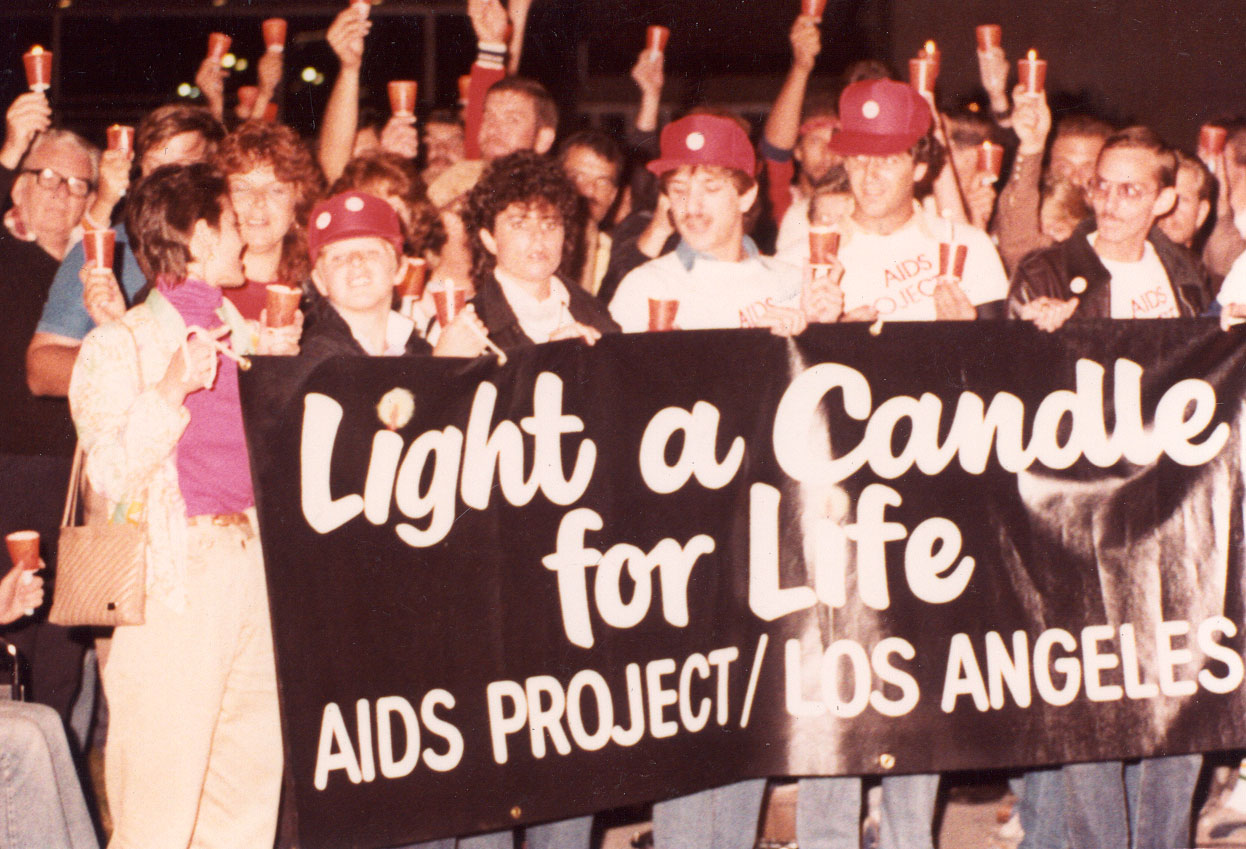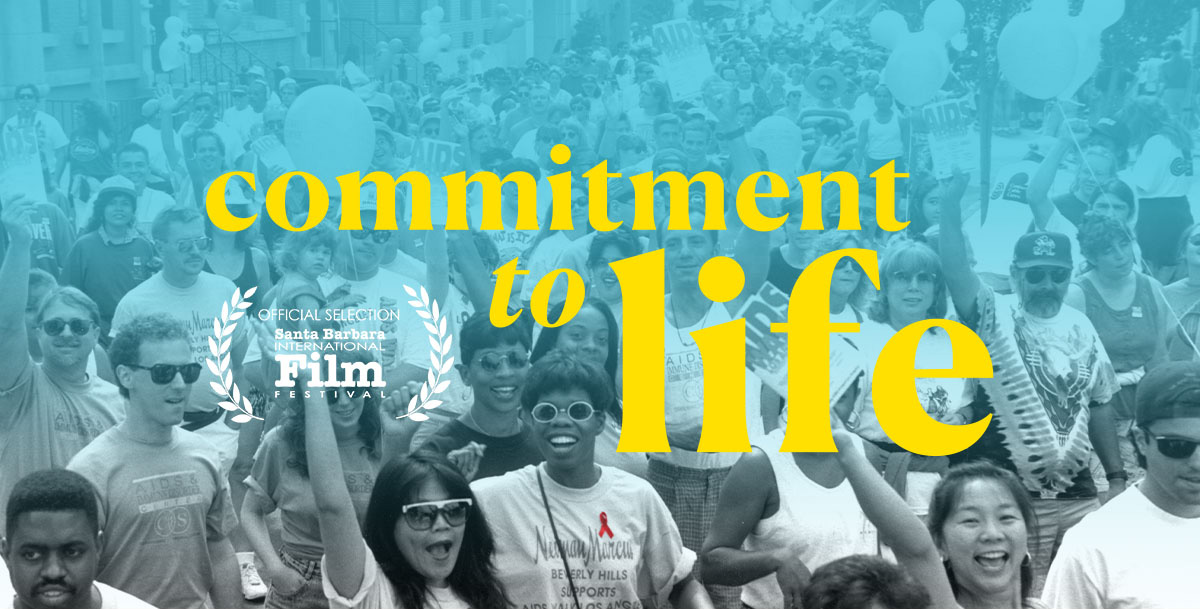Realizing that funds were needed to educate the community and prevent the spread of the disease, the founders enlisted the help of other friends (who became many of APLA’s early volunteers) and held a Christmas benefit. The party raised more than $7,000, which became the seed money for a new organization. Recognizing that AIDS was not just a gay disease, the founders named the organization AIDS Project Los Angeles. The first board of directors was elected on January 14, 1983.
The Founding of AIDS Project Los Angeles
In October 1982, the four founders of AIDS Project Los Angeles (APLA)—Nancy Cole Sawaya, Matt Redman, Ervin Munro, and Max Drew—attended an emergency meeting at the Los Angeles Gay and Lesbian Community Services Center. The meeting featured a presentation by a representative from San Francisco’s Kaposi’s Sarcoma Foundation about Gay Related Immunodeficiency Disease (GRID), one of the early names for AIDS.
Because fears about the new disease were rampant, these four friends set up a telephone hotline to answer questions from the community. They gathered the limited information available and began hotline trainings, with twelve volunteers in the initial group. The hotline was operated from a closet in the Los Angeles Gay and Lesbian Community Services Center, where volunteers answered a single telephone and read information from a one-page fact sheet.
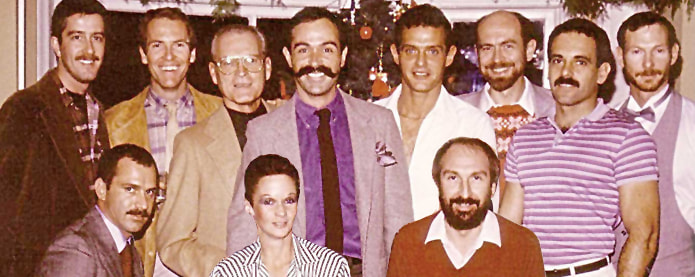
Realizing that funds were needed to educate the community and prevent the spread of the disease, the founders enlisted the help of other friends (who became many of APLA’s early volunteers) and held a Christmas benefit. The party raised more than $7,000, which became the seed money for a new organization. Recognizing that AIDS was not just a gay disease, the founders named the organization AIDS Project Los Angeles. The first board of directors was elected on January 14, 1983.
Candlelight March
From its earliest years, efforts to influence public policy have been a core component of APLA’s mission. In May 1983, APLA sponsored a candlelight march at the Federal Building in Westwood that brought out a crowd of more than 5,000 people. The march was a turning point for community involvement in the struggle against AIDS.
The Founding of Aid for AIDS
Aid for AIDS was founded in 1983 by a small group of friends in the greater Hollywood area to help others in the community devastated by AIDS. By providing emergency rent, mortgage, and utility payments, AFA allowed people to die with dignity in their own homes.
A Year of Firsts
By spring, APLA had served just five clients. That number would grow to 100 by the end of the year. A core of services at AIDS Project Los Angeles took root over the course of that first year.
A Home, Hospital, and Hospice Visitation Program was founded, which soon became the Buddy Program.
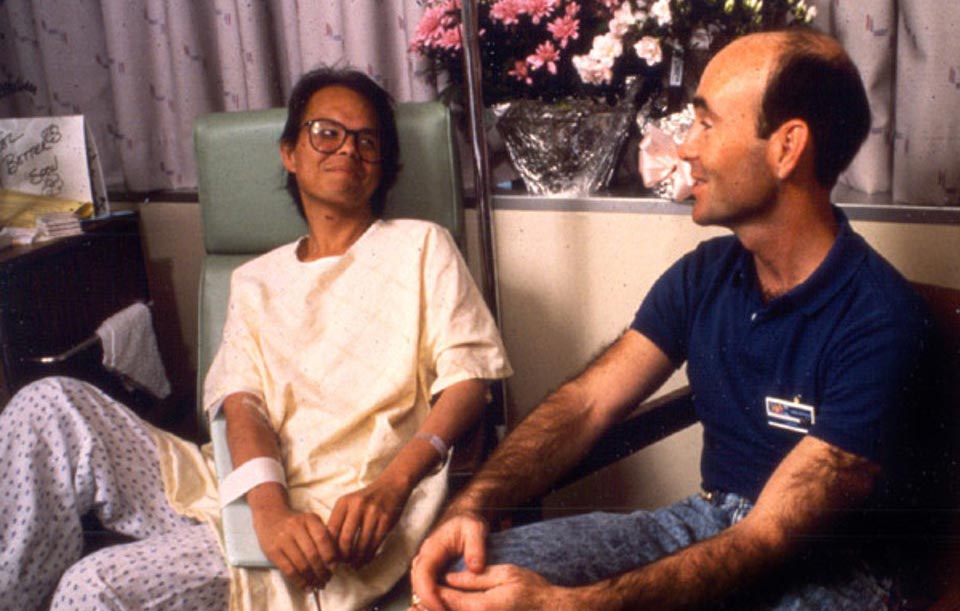
In 1983, the agency also produced and distributed its first brochure on AIDS. It answered basic questions about the disease in English and Spanish. APLA has educated the community ever since to prevent new cases of HIV infection, to empower communities to stay healthy, and to improve the quality of life for people who are living with HIV.
The Hotline — a model of its kind for the nation — continued to educate the community. In its first 18 months, 20,000 calls were handled by volunteers.
A $35-a-week food voucher program for people with AIDS began operating within a movie memorabilia store in Hollywood.
Realizing that funds were needed to educate the community and prevent the spread of the disease, the founders enlisted the help of other friends (who became many of APLA’s early volunteers) and held a Christmas benefit. The party raised more than $7,000, which became the seed money for a new organization. Recognizing that AIDS was not just a gay disease, the founders named the organization AIDS Project Los Angeles. The first board of directors was elected on January 14, 1983.
Housing Services
From the beginning, the number of clients served by APLA grew at a staggering rate. In early 1983, there were five clients. At the end of 1983, there were 100, and by the middle of 1984 there were 200. APLA’s first client service began when early volunteers visited patients at their hospital beds. In early 1984, APLA opened Mansfield House, a three-bedroom hospice, and began offering recreational services and legal, financial and insurance counseling. Support groups were also organized to help people with AIDS and their loved ones.
APLA created new programs during the ensuing years to meet the growing needs of people with AIDS. A program to address housing needs, begun in 1984, has since become a comprehensive Residential Services Program.
Early Fundraisers
Many early fundraising events were held in gay bars and discos as the gay and lesbian community mobilized to fight AIDS. An early fundraiser at Studio One in March 1984, featuring Joan Rivers, raised $45,000 for APLA, L.A. Shanti, and Aid for AIDS.
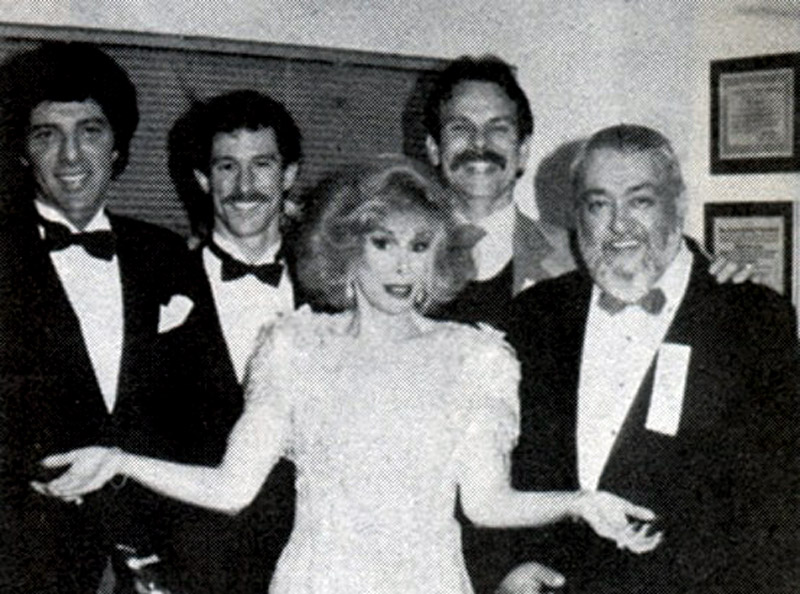
Joan Rivers with Scott Forbes of Studio One and representatives from APLA, Aid for AIDS, and Shanti Foundation
Realizing that funds were needed to educate the community and prevent the spread of the disease, the founders enlisted the help of other friends (who became many of APLA’s early volunteers) and held a Christmas benefit. The party raised more than $7,000, which became the seed money for a new organization. Recognizing that AIDS was not just a gay disease, the founders named the organization AIDS Project Los Angeles. The first board of directors was elected on January 14, 1983.
AIDS Walk Los Angeles
Just days after Rock Hudson's announcement that he had AIDS, APLA held the world’s first AIDS Walk Los Angeles event at Paramount Studios on July 28, 1985. The organizers of AIDS Walk Los Angeles hoped to raise $100,000 that first year, but instead a tide of more than 4,500 walkers raised $673,000.
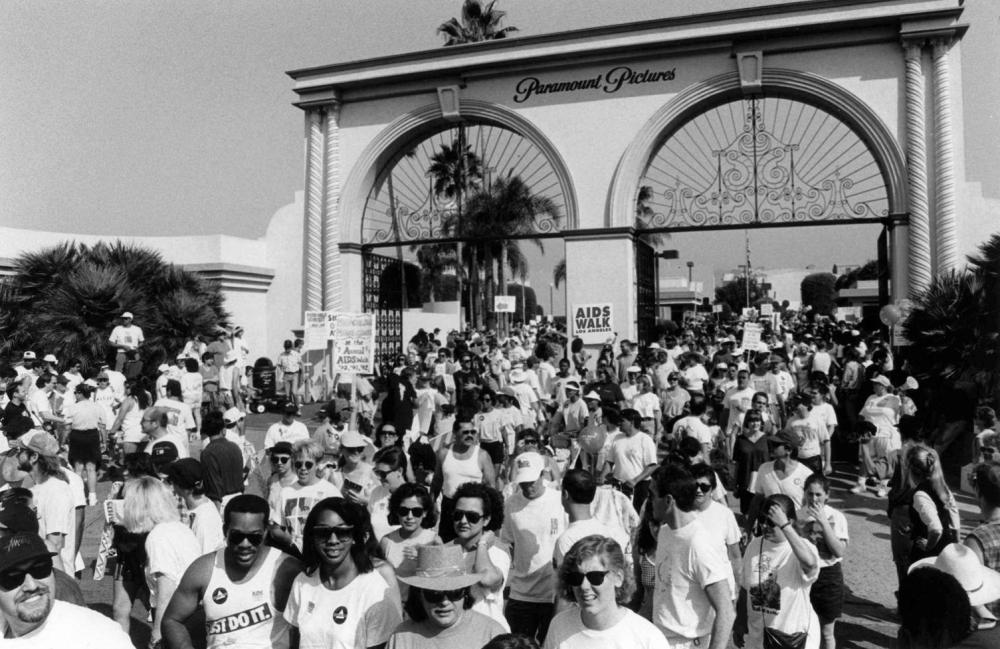
Photo courtesy of Paramount Pictures
Commitment to Life
APLA throws first “Commitment to Life” gala, honoring Betty Ford, and raises $1.3 million with Elizabeth Taylor as host.
Dental Services
Client need, as well as misinformation about how AIDS is contracted, led to establishment of the Raymond E. Greene Dental Clinic, the first dental clinic dedicated to AIDS patients in the country. The clinic, which opened in March 1985, was based in a trailer in West Hollywood Park.
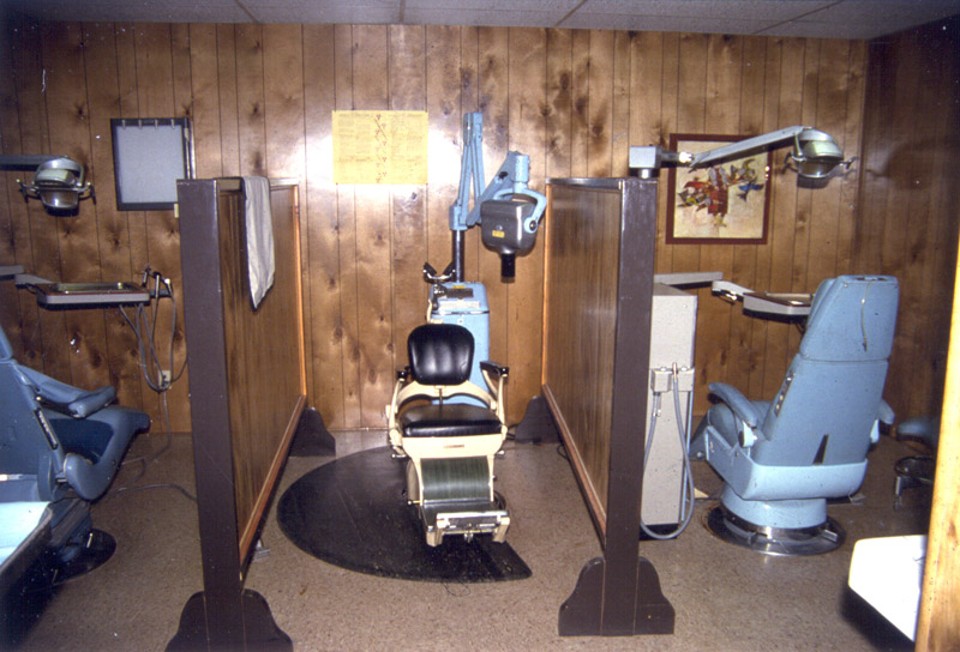
First Major Educational Campaign
The now-famous “LA Cares” ads were produced in conjunction with the Los Angeles Gay and Lesbian Community Services Center. They featured a sweet and motherly character who taught her “boys” about safer sex. Comprised of billboards, public service announcements, and print advertising, the campaign included graphic safer sex guides for gay men titled “Can We Talk?” and “Mother’s Handy Sex Guide.” For a wider audience, APLA and the Center ran a “Southern California Cares” campaign, with the theme “Fight the Fear With the Facts.”
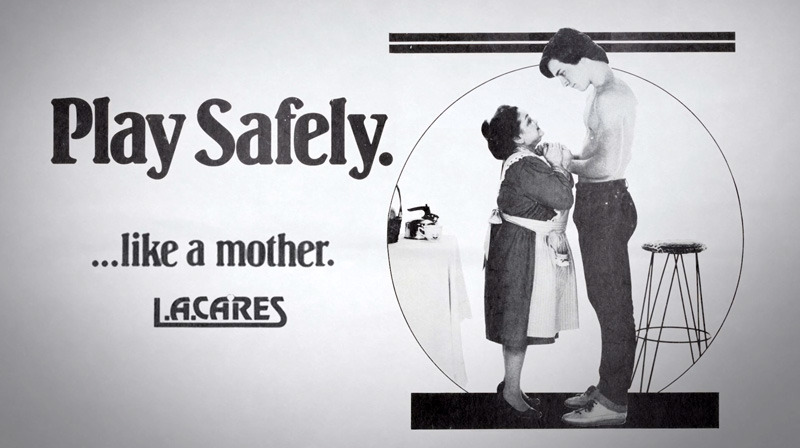
Realizing that funds were needed to educate the community and prevent the spread of the disease, the founders enlisted the help of other friends (who became many of APLA’s early volunteers) and held a Christmas benefit. The party raised more than $7,000, which became the seed money for a new organization. Recognizing that AIDS was not just a gay disease, the founders named the organization AIDS Project Los Angeles. The first board of directors was elected on January 14, 1983.
Necessities of Life Program
One of APLA Health’s most critically needed services, our Necessities of Life Program (NOLP), launches. NOLP’s origins began as a food pantry started by Ken and Alfia Hollywood, who ran a $35-a-week food voucher program out of their movie memorabilia store. In 1986, APLA Health worked with the Hollywoods to open the first Necessities of Life Program food pantry to for people with HIV/AIDS.
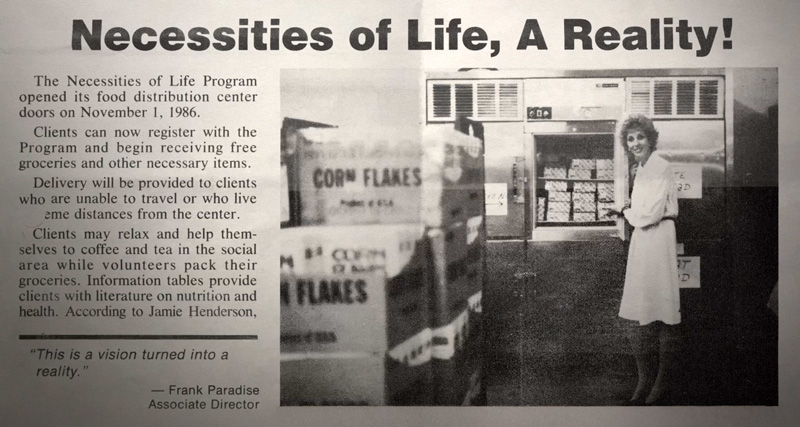
Government Affairs
APLA establishes a Government Affairs Division. Its goals were to increase state and local resources for AIDS prevention, education and care, as well as to promote fair and humane HIV/AIDS legislation.
Realizing that funds were needed to educate the community and prevent the spread of the disease, the founders enlisted the help of other friends (who became many of APLA’s early volunteers) and held a Christmas benefit. The party raised more than $7,000, which became the seed money for a new organization. Recognizing that AIDS was not just a gay disease, the founders named the organization AIDS Project Los Angeles. The first board of directors was elected on January 14, 1983.
Serra Project Founded
The Serra Project founded under the sponsorship of seven major Los Angeles County hospitals and the Catholic Archdiocese in response to the growing number of people left homeless by their battle with acute HIV/AIDS.
New Hope
On March 20, 1987, the fight against HIV/AIDS changed forever when the Food and Drug Administration (FDA) approved zidovudine (AZT) — the first drug ever proven to slow the progression of HIV. For the first time, there was hope that treatment could extend lives and change the trajectory of the epidemic. As the most effective weapon against HIV/AIDS at the time, AZT marked the dawn of antiretroviral therapy and a turning point in the battle against the virus.
Meanwhile, it was only in June 1987, at the third International AIDS Conference, that President Reagan first mentioned the word “AIDS” in public.
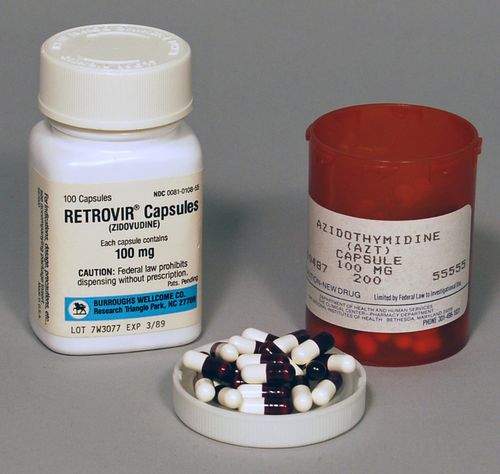
Realizing that funds were needed to educate the community and prevent the spread of the disease, the founders enlisted the help of other friends (who became many of APLA’s early volunteers) and held a Christmas benefit. The party raised more than $7,000, which became the seed money for a new organization. Recognizing that AIDS was not just a gay disease, the founders named the organization AIDS Project Los Angeles. The first board of directors was elected on January 14, 1983.
First Group Home
In 1988, the Serra Project opened the first group home in the City of Los Angeles to later be state licensed as a Residential Care Facility for the Chronically Ill (RCFCI). The home continues to serve destitute, AIDS-impacted adults in need of assisted living and hospice care.
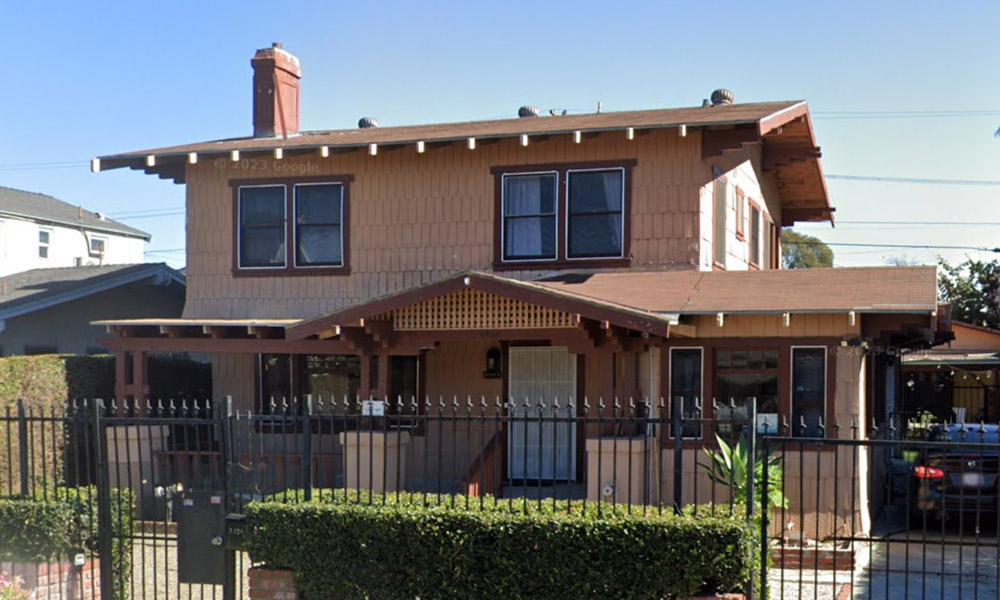
World AIDS Day
The world marks the first-ever observance of World AIDS Day on December 1, a historic moment in the global fight against HIV/AIDS. Designated by the World Health Organization and backed by the United Nations, this inaugural event unites people across the globe under the theme: “Join the Worldwide Effort.”
AIDS Memorial Quilt
Following its inaugural display on the National Mall in Washington D.C. the previous October, the AIDS Memorial Quilt was presented in Pauley Pavilion at UCLA in April 1988 as celebrities, politicians, families, lovers and friends read aloud the 1,920 names of the people represented. Panels were added at each stop of the national tour, and by the end the Quilt consisted of more than 6,000 panels. Today, the AIDS Memorial Quilt includes nearly 50,000 panels and is preserved by the National AIDS Memorial in San Francisco.
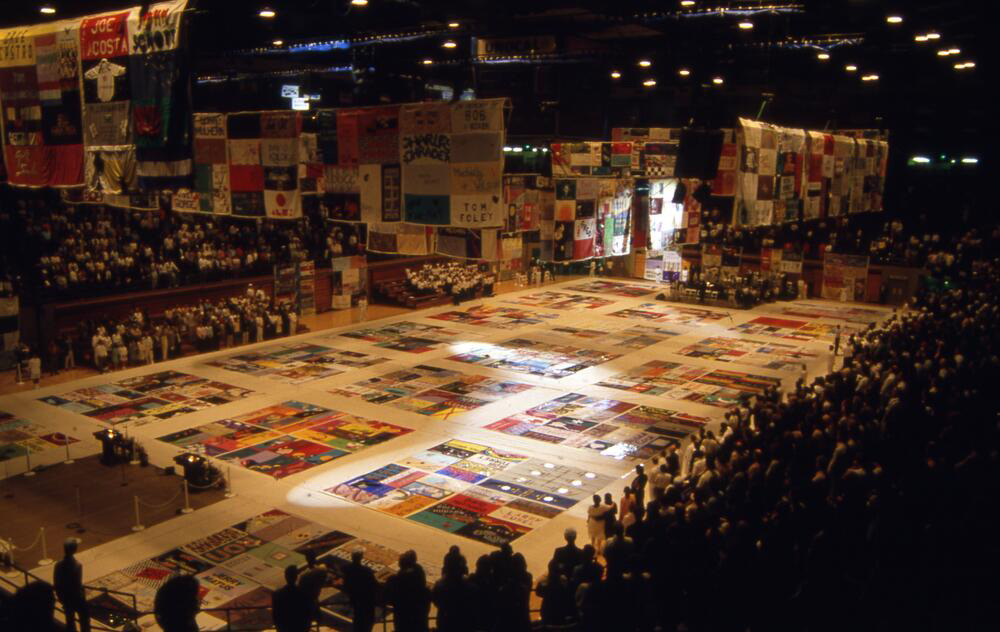
Realizing that funds were needed to educate the community and prevent the spread of the disease, the founders enlisted the help of other friends (who became many of APLA’s early volunteers) and held a Christmas benefit. The party raised more than $7,000, which became the seed money for a new organization. Recognizing that AIDS was not just a gay disease, the founders named the organization AIDS Project Los Angeles. The first board of directors was elected on January 14, 1983.
“Best in Drag Show”
The first iteration of “Best in Drag Show” (known then as “Battle for the Tiara”) launched as a privately organized event with funds benefiting Aid for AIDS.
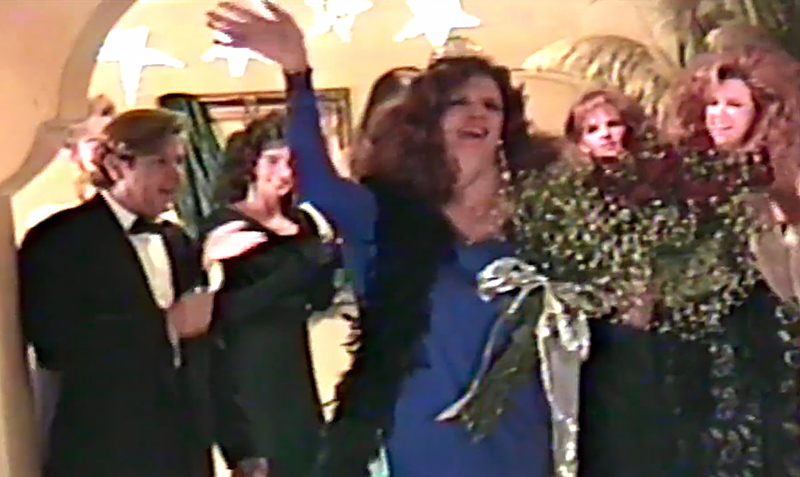
Public Policy Challenges
At APLA, public policy staff helped to defeat dangerous initiatives — including proposals to quarantine gay men — placed on the ballot by extremists determined to exploit the epidemic for political gain.
On a state level, APLA established Sacramento-based AIDS Project Advocacy Services to ensure that responsible legislation would get a fair hearing in the state Capitol.
In Washington, Congress approved $30 million in emergency funding to the states for AZT. Yet it also passed the Helms Amendment, which banned the use of federal funds for AIDS education materials that “promote or encourage, directly or indirectly, homosexual activities” — the infamous “no promo homo policy.”
Realizing that funds were needed to educate the community and prevent the spread of the disease, the founders enlisted the help of other friends (who became many of APLA’s early volunteers) and held a Christmas benefit. The party raised more than $7,000, which became the seed money for a new organization. Recognizing that AIDS was not just a gay disease, the founders named the organization AIDS Project Los Angeles. The first board of directors was elected on January 14, 1983.
West Hollywood Memorial Walk
Aid for AIDS partners with the City of West Hollywood to unveil Tribute to Life/West Hollywood Palms (later renamed West Hollywood Memorial Walk) on Santa Monica Boulevard between Fairfax Avenue and Doheny Drive. Bronze plaques pay tribute to lives lost to HIV/AIDS.
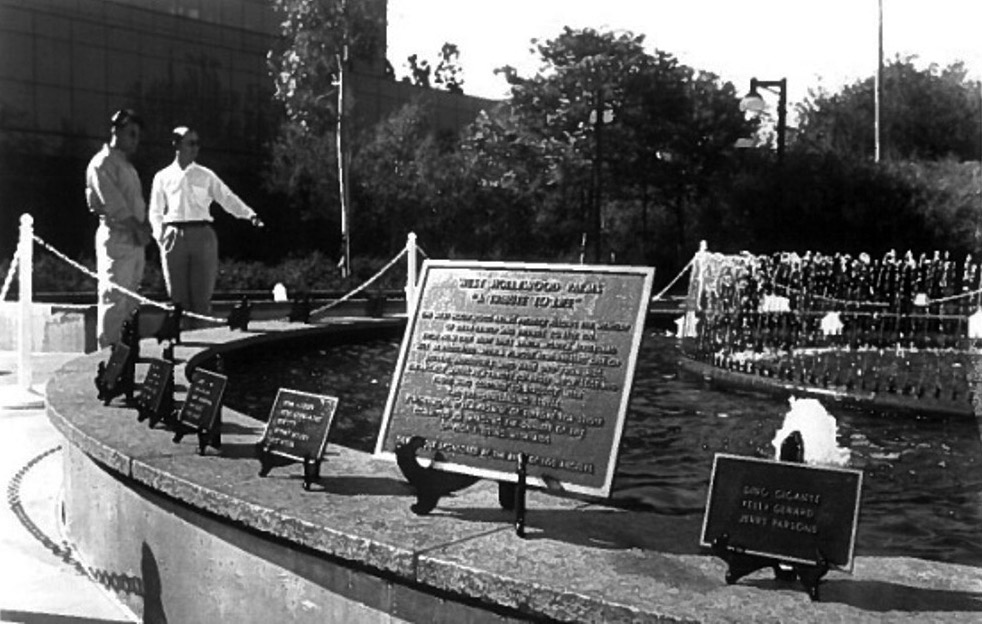
Disturbing Trends
Disturbing new trends became apparent in the AIDS epidemic in the early ‘90s. Incidence of infection among communities of color rose sharply, and numbers of infected women also grew. Mortality due to AIDS was at its highest ever.
The number of new client registrations at APLA soared. The agency registered as many new clients between 1992 and 1995 as were registered in the previous eight years.
As APLA settled into its new facility on Vine Street, reports emerging from the ninth International Conference on AIDS in Berlin in 1993 shattered hopes that HIV infection could be managed successfully by early intervention with existing antiretrovirals.
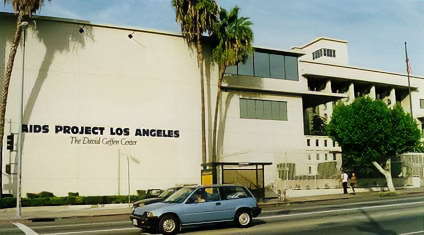
Realizing that funds were needed to educate the community and prevent the spread of the disease, the founders enlisted the help of other friends (who became many of APLA’s early volunteers) and held a Christmas benefit. The party raised more than $7,000, which became the seed money for a new organization. Recognizing that AIDS was not just a gay disease, the founders named the organization AIDS Project Los Angeles. The first board of directors was elected on January 14, 1983.
New Challenges
In 1995, 2,407 new clients were registered at APLA, the highest level ever. By October 31, 500,000 cases of AIDS had been reported in the United States.
A Turning Point
Optimistic reports began to appear that year, when the first protease inhibitor, Invirase, was made available outside of clinical trials. Before year’s end, this new drug, part of the second class of HIV drugs, was approved by FDA.
In the next few years, Invirase and other members of its class would help prolong the life expectancy of people living with HIV and establish a new paradigm for the AIDS epidemic.
Realizing that funds were needed to educate the community and prevent the spread of the disease, the founders enlisted the help of other friends (who became many of APLA’s early volunteers) and held a Christmas benefit. The party raised more than $7,000, which became the seed money for a new organization. Recognizing that AIDS was not just a gay disease, the founders named the organization AIDS Project Los Angeles. The first board of directors was elected on January 14, 1983.
Optimism
The sense of hope was bolstered by an unmistakable downward trend in AIDS mortality. The annual death rate dropped for the first time in 1996, and that trend continued in subsequent years.
Optimism about combination therapy had a powerful impact at APLA. Client caseloads rose, and all APLA programs experienced increased demand, and in some cases, access to programs became based on degree of need.
At the forefront of new services at APLA was the Work Services Program. As more people with HIV considered resuming their careers, APLA was prepared to assist them with the challenge.
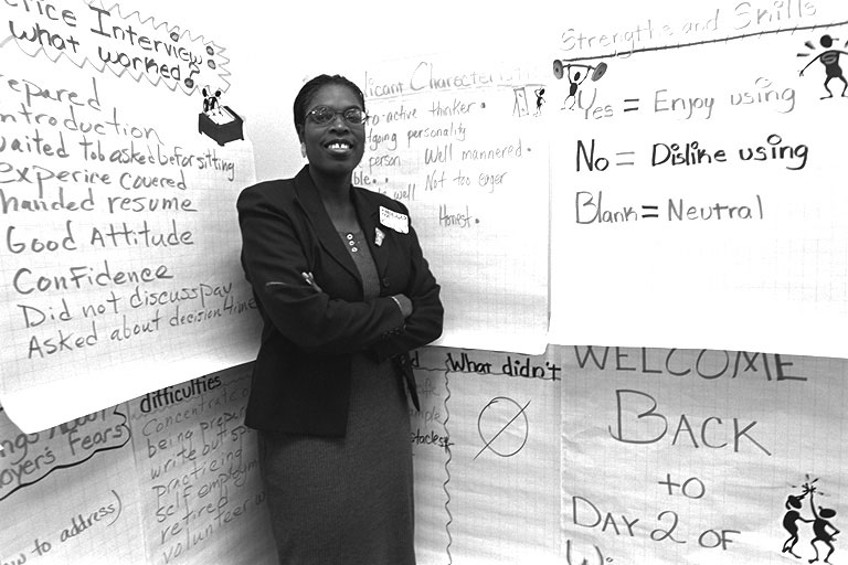
Uneven Progress
A new third class of drugs — NNRTI’s, or the so-called HAART therapy — and the first viral load test to determine the level of HIV in the body are released.
AIDS is no longer leading cause of death for all Americans ages 25-44, although it remains the leading cause of death for African Americans in this age group. In Los Angeles, HIV was now a disease of the poor regardless of their color, and of people of color regardless of their income.
Realizing that funds were needed to educate the community and prevent the spread of the disease, the founders enlisted the help of other friends (who became many of APLA’s early volunteers) and held a Christmas benefit. The party raised more than $7,000, which became the seed money for a new organization. Recognizing that AIDS was not just a gay disease, the founders named the organization AIDS Project Los Angeles. The first board of directors was elected on January 14, 1983.
APLA Expands
From 2001 to 2003, APLA moved closer to its client populations, opening food pantries in South Los Angeles and Long Beach. The agency also moved its main offices to the David Geffen Center on Kingsley Drive, with a new site for the APLA Dental Clinic on Wilshire Boulevard in the Samaritan Medical Tower.
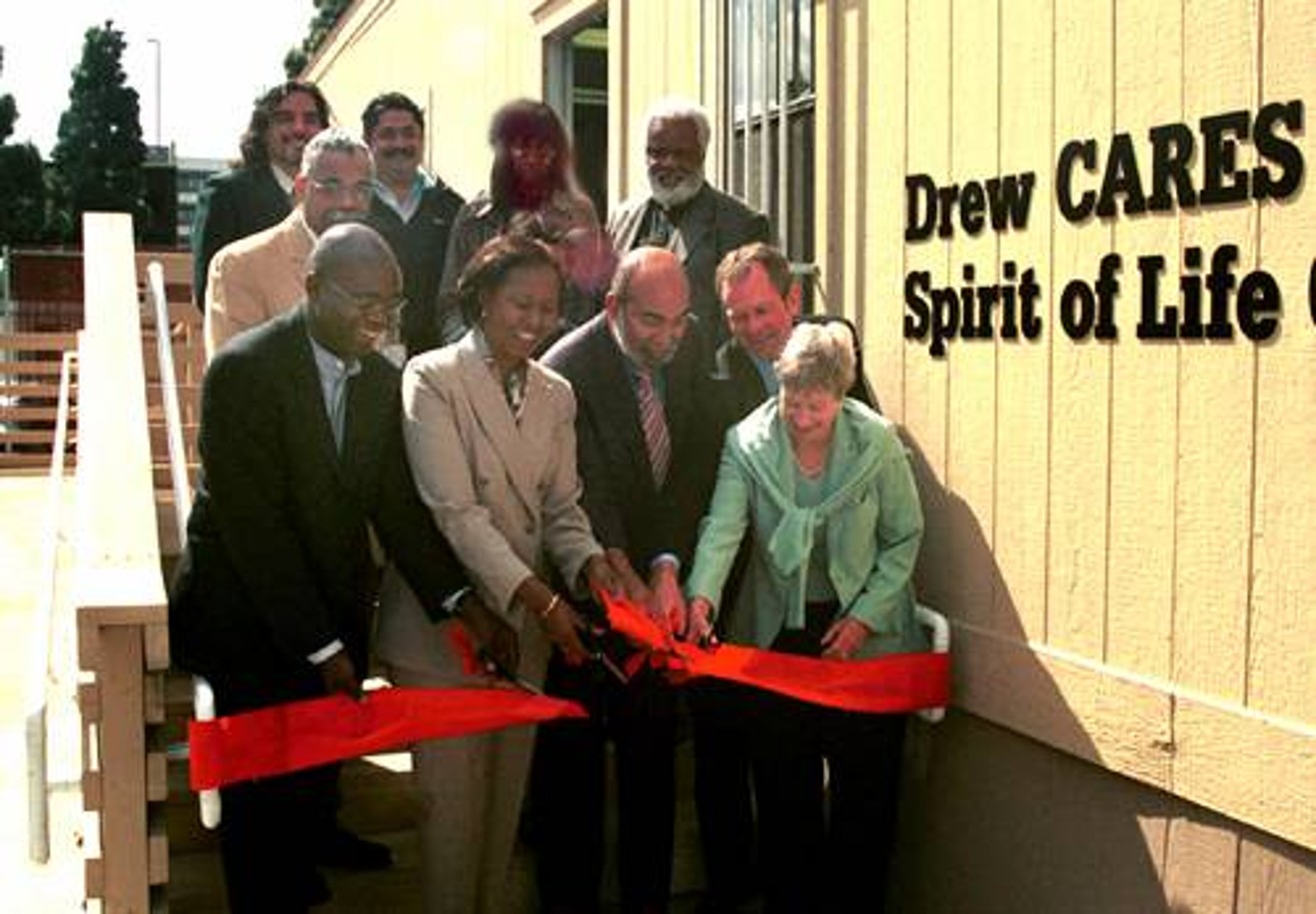
Twenty Years of AIDS
Twenty years after the publication of a report describing unusual infections in otherwise healthy gay men, one million Americans were infected with HIV. Over 40,000 new infections were occurring annually. And every country and continent was feeling the devastating impact of HIV.
After generic drug manufacturers pledge to produce low-cost versions of HIV/AIDS medications for developing countries, several major pharmaceutical companies respond by further lowering their prices—expanding access to life-saving treatment for those in need.
Realizing that funds were needed to educate the community and prevent the spread of the disease, the founders enlisted the help of other friends (who became many of APLA’s early volunteers) and held a Christmas benefit. The party raised more than $7,000, which became the seed money for a new organization. Recognizing that AIDS was not just a gay disease, the founders named the organization AIDS Project Los Angeles. The first board of directors was elected on January 14, 1983.
The Global Forum on MSM & HIV
By the end of 2005, APLA had begun its first international partnership, a project with India-based AIDS service provider YRG CARE. The initiative offered multilingual HIV care and prevention services to women in Tamil Nadu, one of India’s regions hit hardest by the epidemic.
APLA subsequently continued to expand its international efforts with an HIV prevention program for gay men in China; prevention, research, training, and advocacy efforts in Latin America; and a nutrition initiative in South Africa. In 2006, APLA became the secretariat to the Global Forum on MSM & HIV (MSMGF). Guided by a Steering Committee of 20 members from 17 countries around the world, MSMGF worked to promote MSM health and human rights worldwide through advocacy, information exchange, knowledge production, networking, and capacity building.
Hardest Hit
APLA began an HIV prevention partnership with In The Meantime, a gay black men’s group, in response to alarming rates of HIV in urban black gay men.
Gay men and communities of color were, and continue to be, markedly overrepresented among people living with HIV/AIDS. The reasons for this disproportionate impact thought to be related to socioeconomic issues such as poverty, lack of access to quality health care, high rates of un- and underemployment, and limited educational attainment.
Realizing that funds were needed to educate the community and prevent the spread of the disease, the founders enlisted the help of other friends (who became many of APLA’s early volunteers) and held a Christmas benefit. The party raised more than $7,000, which became the seed money for a new organization. Recognizing that AIDS was not just a gay disease, the founders named the organization AIDS Project Los Angeles. The first board of directors was elected on January 14, 1983.
AHH is Formed
Aid for AIDS merges with the Serra Project to create Alliance for Housing & Healing (AHH).
South Los Angeles
APLA continued to expand on its commitment to serve the diverse South Los Angeles community. In 2009, the agency opened its S. Mark Taper Foundation Center, a freestanding dental clinic and food pantry on the Martin Luther King Jr.-Charles Drew University campus in South Los Angeles.
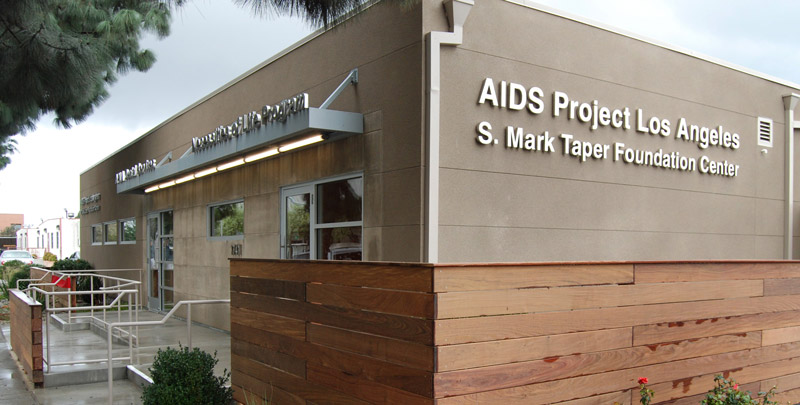
Federal Support
Newly elected President Barack Obama takes a bold step in the fight against HIV/AIDS by calling for the creation of the first-ever National HIV/AIDS Strategy for the United States.
At the global level, he launches the Global Health Initiative (GHI), a six-year, $63 billion effort to transform healthcare in low- and middle-income countries. Central to this initiative is the President’s Emergency Plan for AIDS Relief (PEPFAR), reinforcing the U.S. commitment to combating the HIV/AIDS epidemic worldwide.
Realizing that funds were needed to educate the community and prevent the spread of the disease, the founders enlisted the help of other friends (who became many of APLA’s early volunteers) and held a Christmas benefit. The party raised more than $7,000, which became the seed money for a new organization. Recognizing that AIDS was not just a gay disease, the founders named the organization AIDS Project Los Angeles. The first board of directors was elected on January 14, 1983.
APLA Health & Wellness Center
In 2011, APLA opens the APLA Health & Wellness Center in Baldwin Hills, bringing together HIV prevention services, economic development programs and social activities for gay and bisexual men and transgender individuals of color.
PrEP: A Biomedical Strategy Emerges
In July, groundbreaking research reshapes HIV prevention. A new CDC study and the Partners PrEP trial provide the first compelling evidence that a daily oral dose of the antiretroviral drugs already used to treat HIV can also significantly reduce the risk of infection in uninfected individuals exposed through heterosexual sex.
A week later, scientists announce game-changing results. Two studies confirm that individuals taking daily antiretroviral drugs experienced infection rates more than 60% lower than those on a placebo, marking a major advancement in the fight against HIV.
Realizing that funds were needed to educate the community and prevent the spread of the disease, the founders enlisted the help of other friends (who became many of APLA’s early volunteers) and held a Christmas benefit. The party raised more than $7,000, which became the seed money for a new organization. Recognizing that AIDS was not just a gay disease, the founders named the organization AIDS Project Los Angeles. The first board of directors was elected on January 14, 1983.
New Services
In April, APLA expands health services by implementing STD screening and treatment at the Health & Wellness Center.
Federally Qualified Health Center
In the fall, APLA Health & Wellness is awarded a federal New Access Point grant by the Health Resources Services Administration (HRSA) and becomes a federally qualified health center focusing on healthcare services for low-income LGBT people.
Realizing that funds were needed to educate the community and prevent the spread of the disease, the founders enlisted the help of other friends (who became many of APLA’s early volunteers) and held a Christmas benefit. The party raised more than $7,000, which became the seed money for a new organization. Recognizing that AIDS was not just a gay disease, the founders named the organization AIDS Project Los Angeles. The first board of directors was elected on January 14, 1983.
Gleicher/Chen Health Center
APLA Health & Wellness begins offering primary medical care at the Health & Wellness Center in spring 2014 and undertakes a full renovation of the space, which includes a capital campaign that changed its name. In October of that year, what is now known as the Gleicher/Chen Health Center formally opened in Baldwin Hills, offering a full suite of health services for the community, including primary medical, dental, and behavioral healthcare, HIV testing, STD screening and treatment, and more.
APLA Health & Wellness launched its Pre-Exposure Prophylaxis (PrEP) program at the Gleicher/Chen Health Center in November 2014 and spearheaded the delivery of comprehensive PrEP services with a full-time PrEP navigator, leading the way in the delivery and counseling around this highly effective biomedical intervention in Los Angeles County.
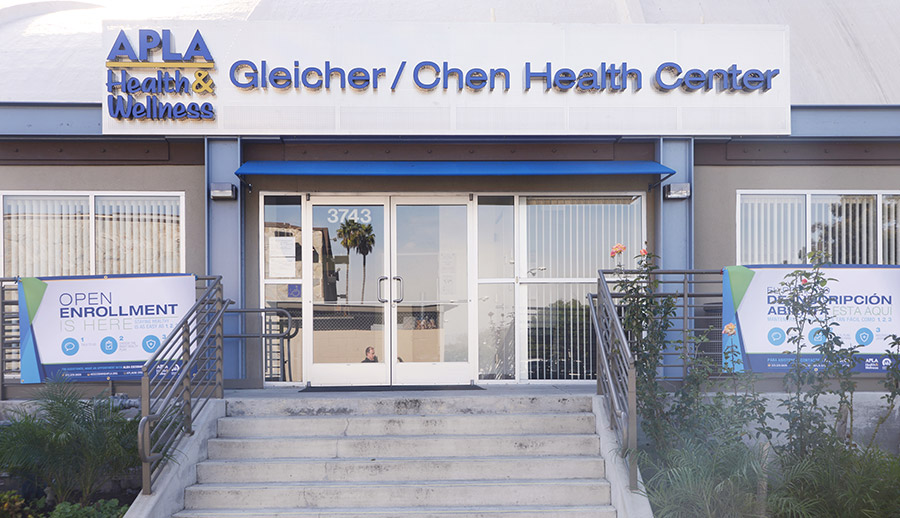
MSMGF Spins Off
Global Forum on MSM & HIV (MSMGF) separates from APLA and becomes its own 501(c)3 nonprofit organization, with APLA continuing to provide administrative support services.
Realizing that funds were needed to educate the community and prevent the spread of the disease, the founders enlisted the help of other friends (who became many of APLA’s early volunteers) and held a Christmas benefit. The party raised more than $7,000, which became the seed money for a new organization. Recognizing that AIDS was not just a gay disease, the founders named the organization AIDS Project Los Angeles. The first board of directors was elected on January 14, 1983.
Health Education Expansion
APLA Health & Wellness Health Education site opens in Baldwin Hills.
U=U: Undetectable equals Untransmittable
Researchers confirm that antiretroviral therapy is a powerful tool in preventing sexual transmission of HIV between partners. The decade-long HPTN 052 clinical trial reveals that when a person living with HIV achieves viral suppression through treatment, the risk of transmitting the virus to an uninfected heterosexual partner is dramatically reduced — solidifying the role of treatment as prevention in the fight against HIV.
Realizing that funds were needed to educate the community and prevent the spread of the disease, the founders enlisted the help of other friends (who became many of APLA’s early volunteers) and held a Christmas benefit. The party raised more than $7,000, which became the seed money for a new organization. Recognizing that AIDS was not just a gay disease, the founders named the organization AIDS Project Los Angeles. The first board of directors was elected on January 14, 1983.
Our Second FQHC Clinic
In the summer of 2015, APLA Health & Wellness was awarded a second New Access Point grant from HRSA to expand the scope of its healthcare services. The organization celebrated the grand opening of the APLA Health Center, Long Beach on the St Mary Medical Center campus in August 2016, with services including medical, dental, and behavioral health care and PrEP.
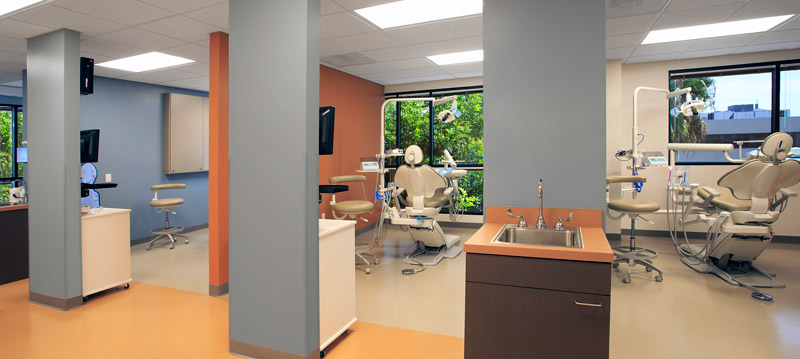
UN Controversy
United Nations member states pledge to end the AIDS epidemic by 2030, but the meeting is marked by controversy when over 50 nations block LGBT groups from attending. The final resolution minimizes those most at risk for contracting HIV/AIDS: men who have sex with men, sex workers, transgender people and people who inject drugs.
Realizing that funds were needed to educate the community and prevent the spread of the disease, the founders enlisted the help of other friends (who became many of APLA’s early volunteers) and held a Christmas benefit. The party raised more than $7,000, which became the seed money for a new organization. Recognizing that AIDS was not just a gay disease, the founders named the organization AIDS Project Los Angeles. The first board of directors was elected on January 14, 1983.
Mid-Wilshire Expansion
APLA Health Board approves acquisition of Global Healthcare LA, which becomes APLA Health Center, Mid-Wilshire.
A Need for Health Equity
The New York Times reports that, taken as a group, America’s black gay and bisexual men have a higher HIV prevalence rate than any nation in the world
Realizing that funds were needed to educate the community and prevent the spread of the disease, the founders enlisted the help of other friends (who became many of APLA’s early volunteers) and held a Christmas benefit. The party raised more than $7,000, which became the seed money for a new organization. Recognizing that AIDS was not just a gay disease, the founders named the organization AIDS Project Los Angeles. The first board of directors was elected on January 14, 1983.
Merger
AIDS Project Los Angeles merges into APLA Health & Wellness and rebrands as APLA Health while maintaining its focus on providing healthcare services to the low-income LGBTQ+ community and individuals living with HIV.
A New Look
The Global Forum on MSM and HIV (MSMGF) changes its name to MPact: Global Action for Gay Men’s Health and Rights.
HIVE
HIV-Elders (HIVE) program created for men with HIV 50 years of age and older to improve their health and well-being by addressing stigma, social isolation, social support, connection, and empowerment.
Realizing that funds were needed to educate the community and prevent the spread of the disease, the founders enlisted the help of other friends (who became many of APLA’s early volunteers) and held a Christmas benefit. The party raised more than $7,000, which became the seed money for a new organization. Recognizing that AIDS was not just a gay disease, the founders named the organization AIDS Project Los Angeles. The first board of directors was elected on January 14, 1983.
Dr. Michael Gottlieb
Dr. Michael Gottlieb moves his private practice to APLA Health Center, Mid-Wilshire.
Progress Slows
A new CDC Vital Signs report shows that progress in reducing new HIV infections in the United States has stalled in recent years and highlights the need for increased HIV testing, treatment, and prevention to end the HIV epidemic in the U.S.
Realizing that funds were needed to educate the community and prevent the spread of the disease, the founders enlisted the help of other friends (who became many of APLA’s early volunteers) and held a Christmas benefit. The party raised more than $7,000, which became the seed money for a new organization. Recognizing that AIDS was not just a gay disease, the founders named the organization AIDS Project Los Angeles. The first board of directors was elected on January 14, 1983.
Alliance Joins APLA Health
Alliance for Housing & Healing becomes a subsidiary of APLA Health & Wellness.
Dental Care Expands
APLA Health Dental Center, Downtown Los Angeles remodels and expands with four new treatment rooms (12 total) and introduces specialty dental care services.
Realizing that funds were needed to educate the community and prevent the spread of the disease, the founders enlisted the help of other friends (who became many of APLA’s early volunteers) and held a Christmas benefit. The party raised more than $7,000, which became the seed money for a new organization. Recognizing that AIDS was not just a gay disease, the founders named the organization AIDS Project Los Angeles. The first board of directors was elected on January 14, 1983.
Out Here Sexual Health
APLA Health opens the Out Here Sexual Health Center, Baldwin Hills, funded in part by LA County as a part of its new Sexual Health Express program.
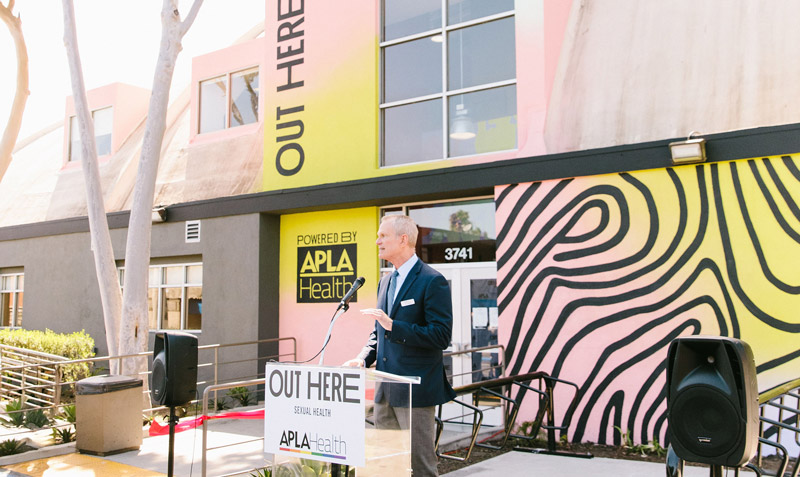
CDU/MLK
APLA Health opens the APLA Health Center, Charles Drew University/Martin Luther King Jr. Medical Campus.
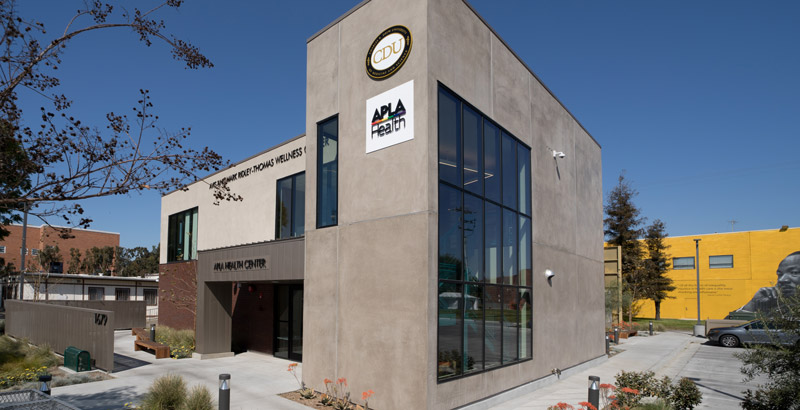
Realizing that funds were needed to educate the community and prevent the spread of the disease, the founders enlisted the help of other friends (who became many of APLA’s early volunteers) and held a Christmas benefit. The party raised more than $7,000, which became the seed money for a new organization. Recognizing that AIDS was not just a gay disease, the founders named the organization AIDS Project Los Angeles. The first board of directors was elected on January 14, 1983.
